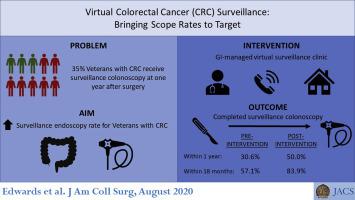Journal of the American College of Surgeons ( IF 3.8 ) Pub Date : 2020-05-23 , DOI: 10.1016/j.jamcollsurg.2020.05.011 Gretchen C Edwards 1 , Kristy K Broman 2 , Richard L Martin 3 , Walter E Smalley 4 , LeaAnne Smith 5 , Rebecca A Snyder 6 , Carmen C Solórzano 7 , Robert S Dittus 8 , Christianne L Roumie 8

|
Background
Although endoscopy is recommended at 1 year after colorectal cancer (CRC) resection to detect locally recurrent CRC, earlier work at our Veterans Affairs (VA) facility demonstrated that 35% of patients achieve this metric.
Study Design
The interdisciplinary team used quality improvement methods to standardize processes and implement a gastroenterology-managed virtual surveillance clinic. The intervention clinic was implemented in August 2014. Veterans who underwent resection for stage I to III CRC at a single VA facility from January 2010 to December 2017 were included, with those undergoing resection between January 2010 and July 2014 considered pre-intervention and those undergoing resection between August 2014 and December 2017 considered post-intervention. The primary endpoint was the proportion of eligible patients for whom endoscopy was completed within 1 year of resection. Secondary outcomes were the proportion of patients who completed endoscopy within 18 months of resection or at any time post-resection and time to surveillance endoscopy.
Results
A total of 186 patients underwent resection for stage I to III CRC from 2010 to 2017; of these, 160 (86%) were eligible for endoscopy at 1-year post-resection (98 pre-intervention and 62 post-intervention). In the pre-intervention period, 30 of 98 patients (30.6%) underwent surveillance endoscopy within 1 year vs 31 of 62 (50.0%) post-intervention (p = 0.031). When evaluated at 18 months after resection, 56 of 98 patients (57.1%) in the pre-intervention group vs 52 of 62 (83.9%) in the post-intervention group underwent surveillance endoscopy (p = 0.001). Median time from resection to endoscopy decreased during the study period, from 1.19 years pre-intervention (interquartile range 0.93 to 1.74 years) to 1.0 years post-intervention (interquartile range 0.93 to 1.09 years) (p = 0.006).
Conclusions
Implementation of a virtual surveillance clinic with standardized processes was associated with increased guideline-concordant endoscopic surveillance after CRC resection.
中文翻译:

虚拟大肠癌监测:将范围率提高到目标。
背景
尽管建议在结直肠癌(CRC)切除后1年进行内镜检查,以检测局部复发的CRC,但我们在退伍军人事务(VA)机构的早期工作表明35%的患者达到了这一指标。
学习规划
跨学科团队使用质量改进方法来标准化流程并实施由胃肠病学管理的虚拟监视诊所。干预诊所于2014年8月开始实施。从2010年1月至2017年12月在单个VA设施接受CRC一期至Ⅲ期手术切除的退伍军人也包括在内,2010年1月至2014年7月间接受手术切除的退伍军人被认为是干预前的,在2014年8月至2017年12月之间进行的切除术被认为是干预后的。主要终点是切除后1年内完成内镜检查的合格患者比例。次要结果是在切除后18个月内或切除后任何时间完成内窥镜检查的患者比例以及进行监督内窥镜检查的时间。
结果
从2010年至2017年,共186例患者接受了I至III期CRC切除术; 其中160例(86%)在切除后1年内有资格接受内镜检查(干预前98例,干预后62例)。在干预前阶段,在98名患者中有30名(30.6%)在一年内接受了监测内窥镜检查,而在干预后的62名中有31名(50.0%)接受了内窥镜检查(p = 0.031)。在切除后18个月进行评估时,干预前组的98例患者中有56例(57.1%),干预后组的62例中有52例(83.9%)接受了内窥镜检查(p = 0.001)。在研究期间,从切除到内窥镜检查的中位时间减少了,从干预前的1.19年(四分位数的范围为0.93至1.74年)到干预后的1.0年(四分位数的范围为0.93至1.09年)(p = 0.006)。
结论
CRC切除后,实施具有标准化流程的虚拟监视诊所与增加指南一致的内窥镜监视相关。











































 京公网安备 11010802027423号
京公网安备 11010802027423号